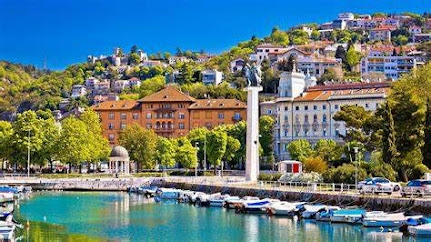Croatia’s third-largest city, Rijeka, will surprise you with its diversity and vitality.
=======================================================================(in western Croatia) Rijeka, the major port and industrial, commercial, and cultural center of this area, is found on the Kvarner (a gulf of the Adriatic Sea); a bustling blend of gritty 20th-century port and Italianate Habsburg grandeur. Rijeka is a vibrant city that combines the charm of its rich history with the modern flair of a bustling port. As the gateway to the Adriatic coast, Rijeka offers a variety of attractions for visitors, from cultural landmarks to natural wonders. You can explore the city's heritage in the Old Town, where you can admire the Roman arch, the medieval castle, and the baroque cathedral. You can also enjoy the lively atmosphere of the Korzo, the main pedestrian street, lined with cafes, shops, and street performers. (For a taste of nature, you can visit the islands of Krk and Cres, or the Učka Nature Park, where you can hike, bike, or ski.)
+ The city is situated on a narrow flatland between the Julian Alps and the Adriatic, spreading up the slopes and onto the landfills on the seafront. The name, dating from the 13th century, refers to the river called Rječina in Serbian and Croatian ()and Fiumara, or Eneo, in Italian, which empties into the Kvarner at Rijeka. The port is a primary naval base and a point of departure for coastal shipping. The coastal section of the Adriatic Highway begins in the city, which also has rail connections to Trieste (Italy), Ljubljana (Slovenia), and Zagreb.
Shipyards and repair facilities, major oil refineries, a paper factory, and a diesel-engine works are industries of major importance.
+ A Roman settlement, Tarsatica, dating from the 3rd century, is thought to have been destroyed by Charlemagne about 800. Avars and Slavs had begun to settle there in the 6th–7th century, and a settlement (Starigrad, meaning “Old City”) had developed on the right bank of the Rječina by the 10th century. In 1471 it was incorporated into Austria, and it was made a free port in 1717, united to Croatia in 1776, and declared an autonomous city of the Hungarian crown in 1779. The French occupied it in the years 1809–14, after which the English expelled the French. Until after World War I, it was alternately under Austrian, Hungarian, and Croatian rule, during which period the buildup of the port and rail connections took place.
+ After 1918 Fiume-Rijeka became a major issue of the postwar peace settlements. At first it was yielded to the new Yugoslav state, but it was returned to Italy in 1924 after Mussolini assumed power and reneged on an agreement for a free state. Yugoslavia retained the suburb of Sušak and certain port privileges. In 1943, during World War II, the Germans took over Rijeka, which suffered extensive damage from Allied air raids. In May 1945, the Yugoslavs liberated the city after heavy fighting.
+ Rijeka has many Baroque buildings, a 13th-century castle, several early churches, and a university.





No comments:
Post a Comment